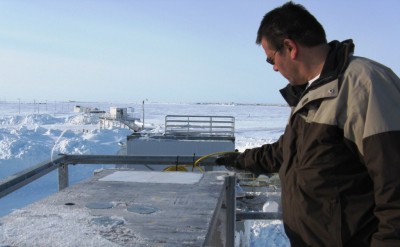Arctic Storm Samples Show Relationship Between Sea Ice and Precipitation Over Land
Published: 1 March 2012

As an important component of Earth’s climate system, sea ice has a particularly strong influence on the Arctic sea surface temperature, evaporation, and reflectivity, or “albedo.” The critical relationship among sea ice, evaporation, and precipitation is linked to a number of climate change effects. At the American Geophysical Union meeting in December 2011, scientists from Dartmouth College presented initial results from their analysis of this relationship using data from the ARM North Slope of Alaska sites in Barrow and Atqasuk between January 2009 and December 2010.
The researchers, funded by the National Science Foundation, analyzed weather patterns and precipitation samples collected from each storm that produced at least 2 millimeters of rain (or 2 centimeters of snow) at the sites. Their results showed that, as hypothesized, a decrease of sea ice does lead to a significant increase in precipitation over land. The increased precipitation, mostly snowfall, increases the albedo, cooling the Arctic and offsetting a large fraction of the heating that caused the original decrease of sea ice.
To conduct this research, each storm was sampled individually because, like sea ice distributions, storm tracks have significant variations. Precipitation samples collected at the site were sent to Dartmouth’s Stable Isotope Geochemistry Lab for analysis of oxygen and hydrogen isotope ratios. Using the isotopic data as well as weather and sea ice information, they were able to determine which part of the ocean surface contributes to the moisture budget.
The Sea Ice Effect on Arctic Precipitation field campaign has been extended through December 2013 to determine how significantly these changes will impact the Arctic. According to Xiahong Feng, principal investigator for the study, the campaign is now duplicating sampling programs in many other Arctic stations under the broader effort known as the “isotopic investigation of sea ice and Precipitation in the Arctic Climate System,” or iisPACS.
“The North Slope will always have a longer data sequence and has been the major data set for testing the concept of our current general sampling and research program,” Feng said. “In addition, our student Kelly Everhart completed her master’s thesis using this data, from which my co-PI, Eric Posmentier, prepared the AGU abstract. We greatly appreciate the support ARM has given us over the years.”
Data collected during the second phase of the campaign are expected to provide a better understanding of the climate information recorded in ice cores. These data are relevant for testing and verification of climate models and other parameters related to Arctic climate change.
The ARM Climate Research Facility is a DOE Office of Science user facility. The ARM Facility is operated by nine DOE national laboratories, including .
Keep up with the Atmospheric Observer
Updates on ARM news, events, and opportunities delivered to your inbox
ARM User Profile
ARM welcomes users from all institutions and nations. A free ARM user account is needed to access ARM data.


















